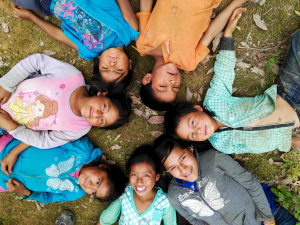Re-learning to live together with Nonviolence.
By: Patricia Olivares

Within the framework of the International Day of Coexistence in Peace, in Amextra we present the values for nonviolence model, which has been applied for more than 20 years in highly marginalized communities in Mexico; and that thanks to its implementation we have been able to reduce violence in the coexistence of children and adolescents in school environments, but also of teachers, mothers and fathers.
Verónica Vera Jiménez, member of the Board of Directors of Amextra and Advisor at Amextra Consultores, who currently coordinates the project on the prevention of violence in Tzeltal communities in Ocosingo (Community Narrative Practice), explains the experience of creating and systematizing this model.
The Values for Nonviolence program arises from the need to address the violence that was generated in the children at the Ajusco Medio Children’s Center, because some situations of violence and sexual abuse began to be detected in the school environment.

The case of 3 girls who suffered sexual abuse by their father, where the mother denied such an act, opened a paradigm of Amextra’s intervention in the communities where it served; because it it proceeded legally, the mother would be imprisoned and, consequently, the 11 year old girl who was denouncing, to protect her 8 and 5 year old sister, would also deny it so as not harm her mother.
At that time, Veronica provided psycho-pedagogical support in Amextra children’s centers, which had cases of infants with learning and psychological problems, for this reason, she began to face these difficult situations for children in the communities.
Another case that set a precedent for this model was that of a girl who was sexually abused by her primary school teacher; this little girl was cared for in the educational center of the Anabaptist church in the area, with whom we worked together for her educational program.
“It was a very serious situation because they were children who were in a single group, and it was something aberrant, how this teacher abused the little girl in front of the whole group. We tried to report it, we had threats [and given the lack of support from parents, school authorities and the community itself] one of the advisors from the prosecutor’s office told us: So, that’s when we began to question ourselves, how do we rescue this situation?”
The first strategy was to train promoters to work with “support groups” for mothers and fathers, because when the mothers of the children who were abused and mistreated were interviewed, it could be seen that they also had a history of violence. Initially, 60% of the children who had an educational problem also had a situation of violence at home or at school.

Later, the people who participated in Amextra’s and the church’s educational programs began to receive training in human rights and abuse prevention. With this, they were able to identify the opportunities and resources they had as a community and, “we saw that schools were a good place to work on prevention”.
For generations, abuse and violence have been normalized to discipline girls and boys, to educate them, because, “violence is learned and that is why we must re-learn how to face conflict and how to relate to each other”. Thus, inspired by the model Capacities and Competencies for Nonviolence developed by Greta Papadimitriou Camara and Sinu Romo Reza from the University of Zacatecas; and the work of the school for peace and values for nonviolence, in Amextra began to build -a group of volunteers who worked in primary and secondary schools- a new intervention model.
The Values for Nonviolence model lasts 3 consecutive years and focuses on working with fourth grade elementary school children, who then go on to fifth grade and conclude their basic education in sixth grade. The intention is to re-learn different ways of dealing with conflict.
“Conflict is something natural, innate in human beings and every day we are faced with conflict. It is not that a good person should not have conflicts, rather, it is the way in which we face them, which can be something violent or a way to transform it, to win all, to solve it or face it”.

During 3 years valuable skills are acquired to face the conflict; the first module consists of working on the skills to strengthen myself; the second module consists of the construction of us; and in the third, we already have school mediators who help transform conflicts between them. For this reason, a committee of parents, teachers and students is formed. so that, when a conflict occurs, the case is addressed in the committee and there is a mediation.
In this process, the teachers who teach the model are accompanied by socio-affective sessions, where an introspection of the problem is generated, then how to generate a response in a different way and reach the resolution of a non-violent conflict. Afterwards, what is learned is analyzed and tasks are left to be applied in daily life.
“It is recommended that teachers work on it in the Civics and Ethics subject, because it matches quite well the topics they have, they are given materials, and it is easy to conduct the session. It is necessary to have a minimum of one session per week and to reinforce it with exercises during the rest of the days [and finally] to carry out a closing activities of the skills and values that have been worked on during the whole cycle”.

This model has been implemented in urban communities in the State of Mexico, Lomas de San Isidro and Tultitlan, and in rural communities in Guerrero and Chiapas. In addition, “It was adapted to work in evangelical churches where they have Sunday schools. A group of teachers was prepared who can take it for 3 months and several pastors have adapted it to their churches”. So it is replicable and adapted according to the context.
The term Nonviolence promoted by Amextra has its origin in Gandhi and the Sermon on the Mount, but it consists more in “having a philosophy of life, where welfare processes are promoted for all, justice, rights of the most vulnerable, support and Let the voice of those of us who listen to each other be heard. A job that has to do with social and economic justice, where power is symmetrical”.
In Amextra, within its philosophy, Christian values are handled and therefore, “one of the issues that Jesus emphasizes in his teachings, it has to do with these characteristics in the construction of a common good, where there is justice, an attitude of mercy and respect towards other people. That is to live in daily life, to be able to denounce, but also to work on ourselves, these aspects that sometimes we do not see, but that we have: how we use our power, how we exercise our authority, how we relate to the most vulnerable people, and how sometimes we generate violence and unjust moments, we generate injustices in our relationships and positions”.
One of the peculiarities of this model is that with the socio-affective methodology, it helps the brain to begin to have other response paths, a change in behavior that is also neuronal. “It is not about generating blame, but about how to change it and re-learn, therefore, other models lose their effectiveness in practice”.
For Amextra, to speak of nonviolence is to prepare for conflict, not to avoid it, that is to say, the invention: “how am I going to prepare myself to respond in a different way to conflict than how I used to face it or how I have learned to respond to conflict”. And in the context we are currently living in after the COVID-19 pandemic, the formation of Values for Nonviolence is fundamental to rebuild our society.
“We have to be aware that violence affects us as a society, it makes us sick. We can change. We can change, relearn different ways of coexistence, and build family and community spaces of respect and where we can and build family and community spaces of respect and where we can develop our full potential.”

If you want to know more about the Values for Nonviolence model, click here or contact us.
© 2023 Amextra, Asociación Mexicana de Transformación Rural y Urbana A.C. Todos los derechos reservados, México 2017-2023.








Leave a Reply